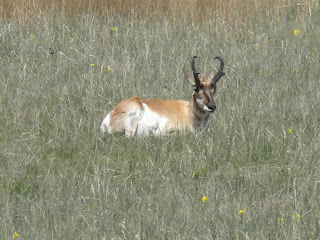 While in South Dakota, I took a number of hikes. Two in particular are noteworthy because of the pictures I was able to gather while hiking. This is a fairly typical view of the Black Hills. Granite rock formations, like the ones in the foreground, break through the pine forests everywhere. These create a certain eeriness, since they can cause the landscape to look rather unearthly in places. They often appear to be huge meteors, or, when clustered together over a wide enough space, a piece of lunar terrain that has been terribly misplaced. The pine trees that make up the majority of the area’s vegetation, and the entirety of the arboreal life, give the Black Hills their name. The Hills were originally called Paha Sapa by the Sioux. Meaning, “Hills of Darkness,” it’s derived from the appearance of the Ponderosa-covered Hills across the plains.
While in South Dakota, I took a number of hikes. Two in particular are noteworthy because of the pictures I was able to gather while hiking. This is a fairly typical view of the Black Hills. Granite rock formations, like the ones in the foreground, break through the pine forests everywhere. These create a certain eeriness, since they can cause the landscape to look rather unearthly in places. They often appear to be huge meteors, or, when clustered together over a wide enough space, a piece of lunar terrain that has been terribly misplaced. The pine trees that make up the majority of the area’s vegetation, and the entirety of the arboreal life, give the Black Hills their name. The Hills were originally called Paha Sapa by the Sioux. Meaning, “Hills of Darkness,” it’s derived from the appearance of the Ponderosa-covered Hills across the plains. 
Snow! In the Hills, snow lasts in shady places, and even continues to fall, into June. Of course, being from the Land of Snowless Winters, also called Chattanooga, I was quite excited to discover this wonder, and jealous of my Dakotan neighbors.

This is the old firetower atop Harney Peak. From here, where one can see for scores of miles across the Hills, rangers used to watch for forest fires. Now, the tower is vacant, but open to the public.
Harney Peak, at well over 7,000 feet above see level, is the highest point between the Rockies and the Alps. From here, one can see four states and numerous national landmarks, including the back of Mount Rushmore.




These last two, taken on separate hikes, are shots of granite spires, for which the Black Hills are famous. The unique formations are the subject of numerous Indian legends, and offer rock climbers some of the most challenging climbs available. The original idea for Mount Rushmore came from these spires, when a historian from the Dakotas decided that Americans needed a revival of patriotism. His idea was to carve a few of these spires into sculptures of Wild West heroes like Wild Bill and Annie Oakley. Because the spires were too brittle to be carved, Rushmore was sought out. Once it was decided that presidents were a more appropriate subject, the Mount Rushmore National Memorial was born.
Speaking of…




Mount Rushmore is a pretty incredible Memorial. The carving is impressive, but when one visits the Memorial’s museum and begins to understand the superhuman effort of turning a mountain into a sculpture, it is truly staggering. It is a fantastically successful memorial in that experiencing the sight of it, and understanding the passionate American patriotism that motivated its creation, gives one a strong sense of national pride. More, having this experience in the midst of hundreds of other Americans creates a strong feeling of American unity. It’s remarkable.




These are shots from a drive on Custer’s wilderness loop. Note the young buffalo. Many of these calves are a month or less old, and they seem to me much more cow-like at this stage than as adults.
So that’s a look at South Dakotan wild space, as typical as I could make it. It’s a hiker’s paradise.


No comments:
Post a Comment